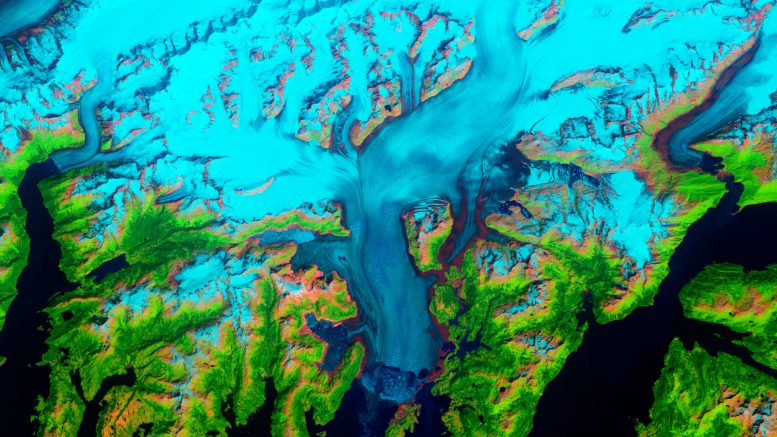
False-color image of Columbia Glacier captured by Landsat satellites. Snow and ice appear bright cyan, vegetation is green, clouds are white or light orange, and open water is dark blue. The exposed bedrock is brown, while rocky debris on the glacier’s surface is gray. Credit: NASA/USGS/Landsat/Jesse Allen and Robert Simmon
The Columbia Glacier descends from an ice field 10,000 feet (3,050 meters) above sea level, down the flanks of the Chugach Mountains, and into a narrow inlet that leads into Prince William Sound in southeastern Alaska. It is one of the most rapidly changing glaciers in the world. Changes to the Columbia Glacier were tracked over more than 30 years using data from Landsat 4, 5, 7, and 8 data.
The Columbia is a large tidewater glacier, flowing directly into the sea. When British explorers first surveyed it in 1794, its nose—or terminus—extended south to the northern edge of Heather Island, a small island near the mouth of Columbia Bay. The glacier held that position until 1980, when it began a rapid retreat that continues today.
False-color images, captured by Landsat satellites, show how the glacier and the surrounding landscape has changed since 1986. The images were collected by similar sensors—the Thematic Mapper (TM), the Enhanced Thematic Mapper Plus (ETM+), and the Operational Land Imager (OLI)—on four different Landsat satellites (4, 5, 7, and 8).
The Landsat images combine shortwave-infrared, near-infrared, and green portions of the electromagnetic spectrum. With this combination of wavelengths, snow and ice appear bright cyan, vegetation is green, clouds are white or light orange, and open water is dark blue. The exposed bedrock is brown, while rocky debris on the glacier’s surface is gray.
Over the past three decades, the terminus had retreated more than 12 miles (20 kilometers) to the north, moving past Terentiev Lake and Great Nunatak Peak. In some years, the terminus retreated more than a kilometer, though the pace has been uneven. The movement of the terminus stalled between 2000 and 2006, for example, because the Great Nunatak Peak and Kadin Peak (directly to the west) constricted the glacier’s movement and held the ice in place. Since the 1980s, the glacier has lost about half of its total thickness and volume. Rings of freshly exposed rock, known as trimlines, become especially prominent around the inlet throughout the 2000s.
Like bulldozers, glaciers lift, carry, and deposit sediment, rock, and other debris from Earth’s surface. This mass accumulates on leading edges in piles called moraines. The Columbia’s moraine created a shallow underwater ridge, or shoal, that prevents the mélange from drifting beyond it.
When the glacier retreated off the moraine around 1980, the terminus lost a key source of support. Once freed from this anchoring point, the grinding and dragging between the sea floor and the massive block of ice was reduced, increasing the rate at which ice flowed forward and icebergs calved from the glacier.
The retreat has also changed the way the glacier flows. The retreat of the Columbia contributes to global sea-level rise, mostly through iceberg calving.



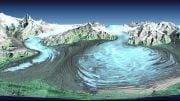
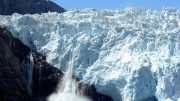

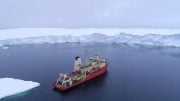
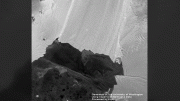

Be the first to comment on "NASA Views One of the Most Rapidly Changing Glaciers in the World"